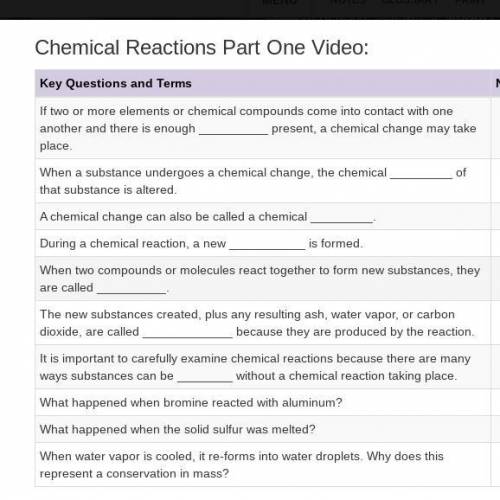Help me pls
words from the video:
What do fireworks, a fried egg, and a rusting vehicl...

Chemistry, 13.12.2021 21:40 hectorav6619
Help me pls
words from the video:
What do fireworks, a fried egg, and a rusting vehicle have in common? They all involve chemical reactions. If two or more elements or chemical compounds come into contact with one another and there is enough energy present, a chemical change may take place.
When a substance undergoes a chemical change, the chemical structure of that substance is altered. A chemical change can also be called a chemical reaction. During a chemical reaction a new substance is formed.
Observe the chemical reaction between bromine and aluminum. Pieces of aluminum are cut from a strip of foil and added to liquid bromine. At first there is no reaction because of the protective oxide coating on the aluminum. But soon an exothermic reaction between bromine and aluminum causes brown fumes of bromine to be given off. But as a new substance, aluminum bromide is produced. White smoke is produced.
The resulting residue is also aluminum bromide. When two compounds or molecules react together to form new substances, they are called reactants. They new substances created plus any resulting ash, water vapor, or carbon dioxide are called products, because they are produced by the reaction.
Some chemical reactions, such as the explosion of fireworks, can happen very fast—in less than a second.
Others, like the rusting of a car, might take years. It is important to carefully examine chemical reactions because there are many ways substances can be changed without a chemical reaction taking place.
Changes of state, for example, from a solid to a liquid or from a liquid to a gas, always involve a physical change rather than a chemical one. Melting sulfur is a good example. When solid sulfur is heated to 120 degrees Celsius it melts and first forms a pale yellow liquid.
In this form the atoms are covalently bonded and the liquid can flow easily. However, heated up beyond 150 degrees Celsius, the result is a dark red liquid that is over 2,000 times stickier. The sulfur may have changed physically but it's still sulfur.
No chemical reaction has taken place. Most of the time changes of state can be reversed by either adding or taking away heat. When water is boiled, for example, water vapor molecules are released in the process.
If you captured all the vapor molecules in a container they would reform again as water droplets once the vapor cooled. When a chemical change occurs it is more difficult to revert the substance back to its original state.



Answers: 3
Another question on Chemistry

Chemistry, 21.06.2019 23:40
If the atomic mass of an atom is 34 and the atom contains 13 protons, how many neutrons does the atom contain?
Answers: 2

Chemistry, 22.06.2019 00:00
How did planetesmals form planets? a. they broke apart into smaller chunks.b. they collided and stuck together.c. they cooled and pulled ice together.d. they began to rotate.
Answers: 1

Chemistry, 22.06.2019 08:00
Define dew point. i am writing this part to be able to ask the question
Answers: 1

Chemistry, 22.06.2019 12:00
In the following redox reaction which is the oxidizing agent and which is the reducing agent? alcl3 + na nacl + al oxidizing agent = reducing agent =
Answers: 1
You know the right answer?
Questions




Mathematics, 27.05.2020 18:01


Mathematics, 27.05.2020 18:01




Business, 27.05.2020 18:01


Mathematics, 27.05.2020 18:01

World Languages, 27.05.2020 18:01






Computers and Technology, 27.05.2020 18:01



